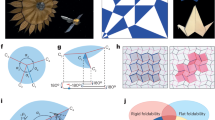Abstract
We present a computing environment for origami on the web. The environment consists of the computational origami engine Eos for origami construction, visualization, and geometrical reasoning, WebEos for providing web interface to the functionalities of Eos, and web service system Scorum for symbolic computing web services. WebEos is developed using Web2.0 technologies, and provides a graphical interactive web interface for origami construction and proving. In Scorum, we are preparing web services for a wide range of symbolic computing systems, and are using these services in our origami environment. We explain the functionalities of this environment, and discuss its architectural and technological features.
Similar content being viewed by others
Explore related subjects
Discover the latest articles and news from researchers in related subjects, suggested using machine learning.References
Demaine E D, Demaine M L. Recent results in computational origami. In: Thomas Hull, ed. Origami3: 3rd International Meeting of Origami Science, Mathematics and Education. Natick, 2002, 3–16
Ida T, Ţepeneu D, Buchberger B, et al. Proving and constraint solving in computational origami. In: Proceedings of AISC 2004. LNAI, 2004, 3249: 132–142
Ida T, Takahashi H, Marin M, et al. Computational origami system Eos. In: Proceedings of OSME. Caltech, 2006, 69
Kasem A, Takahashi H, Marin M, et al. Weborigami2: a system for origami construction and proving using web 2.0 technologies. In: Proceedings of JSSST. Nara, 2007
Naifer M, Kasem A, Ida T. A system of web services for symbolic computation. In: Ida T, Jiang Q S, Wang D M, eds. Proceedings of the 5th Asian Workshop on Foundations of Software. Xiamen: Beihang University, 2007, 145–152
Wolfram Research. Mathematica. http://www.wolfram.com/products/mathematica/, 2007
Huzita H. Axiomatic development of origami geometry. In: Huzita H, ed. Proceedings of the First International Meeting of Origami Science and Technology. 1989, 143–158
Hatori K. K’s origami: origami construction. http://origami.ousaan.com/library/conste.html, 2006
Google. Google web toolkit. http://code.google.com/webtoolkit/, 2006
Wolfram Research. webMathematica 2. http://www.wolfram.com/products/webmathematica, 2006
Kasem A, Ida T, Takahashi H, et al. E-origami system Eos. In: Proceedings of JSSST. Tokyo, 2006
W3C Technical Reports. The xmlhttprequest object. http://www.w3.org/TR/XMLhttpRequest, 2007
Wikipedia website. Ajax (programming). http://en.wikipedia.org/wiki/Ajax_%28programming%29, 2007
Maplesoft. Maple system. http://www.maplesoft.com/, 2007
CoCoATeam. CoCoA: a system for doing computations in commutative algebra. http://cocoa.dima.unige.it
SINGULAR team. SINGULAR computer algebra system. http://www.singular.uni-kl.de/index.html, 2007
Design Science Inc. WebEQ developers suite. http://www.dessci.com/en/products/webeq/, 2007
Ida T, Takahashi H, Marin M, et al. Computational construction of a maximal equilateral triangle inscribed in an origami. In: Mathematical Software-ICMS 2006. Berlin: Springer, LNCS, 2006, 4151: 361–372
Lang R J. Origami simulation. http://www.langorigami.com/science/origamisim/origamisim.php4
Fastag J. Egami: virtual paperfolding and diagramming software. In: Proceedings of OSME. Caltech, 2006, 68
Miyazaki S, Yasuda T, Yokoi S, et al. An origami playing simulator in the virtual space. The Journal of Visualization and Computer Animation, 1996, 7(1): 25–42
Mitani J. Recognition, modeling and rendering method for origami using 2d bar codes. In: Proceedings of OSME. Caltech, 2006
Andersen E M. Origami and math. http://www.paperfolding.com/math
Lang R J. Intersections between origami, mathematics, and science. http://www.langorigami.com/science/science.php4
Hammond K, Al Zain A, Cooperman, et al. Symgrid: a framework for symbolic computation on the grid. In: Kermarreca A M, Bouge L, Priol T, eds. Proceedings of Parallel and Distributed Computing, EuroPar. Berlin: Springer, LNCS, 2007, 4641: 447–456
Carstea A, Frincu M, Macariu G, et al. Generic access to web an grid-based symbolic computing services. Proceedings of ISPDC. Los Alamitos: IEEE Computer Press, 2007, 143–150
Petcu D, Ţepeneu D, Paprzycki M, et al. Symbolic Computations on Grids. In: di Martino B, Dongarra J, Hoisie A, et al, eds. Engineering The Grid: status and perspective. American Scientific Publishers, 2006, 91–107
Author information
Authors and Affiliations
Corresponding author
Rights and permissions
About this article
Cite this article
Kasem, A., Ida, T. Computational origami environment on the web. Front. Comput. Sci. China 2, 39–54 (2008). https://doi.org/10.1007/s11704-008-0009-8
Received:
Accepted:
Published:
Issue Date:
DOI: https://doi.org/10.1007/s11704-008-0009-8




